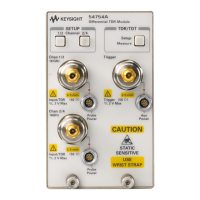Setup Channel Menu
User Calibrations
3-20
External Scale
The channels have a setting which allows the user to enter in an offset value to
compensate for gains or losses not associated with the device under test. This
feature is useful for adjusting out the effects of devices such as test fixtures and
attenuators so that the reading on the display gives the measurement value
associated with only the actual device under test.
To adjust the external scale
1 Press the plug-in module’s front-panel channel SETUP key.
2 Press
Alternate Scale
, and set the
Atten units
to "decibel".
3 Press
Attenuation
, and enter the appropriate values.
Channel Skew Calibration
The skew calibration changes the horizontal position of a waveform on the
display. The skew calibration has a range of approximately 100 µs. You can use
skew to compensate for the differences in cable or probe lengths. It also allows
you to place the trigger edge at the center of the display when you are using a
power splitter connected between the channel and trigger inputs. Another use
for skew is when you are comparing two waveforms that have a timing
difference. If you are interested in comparing the shapes of two waveforms
rather than the actual timing difference, you can use skew to overlay one
waveform on top of the other waveform.
To skew two channels
1 Turn both channels on and overlay the signals vertically.
2 Expand the time base so that the rising edges are at about a 45° angle.
3 Press the plug-in module’s front-panel channel SETUP key.
4 Press
Calibrate
and then
Skew
.
5 Adjust the skew on one of the channels so that the rising edges overlap at the 50%
points.

